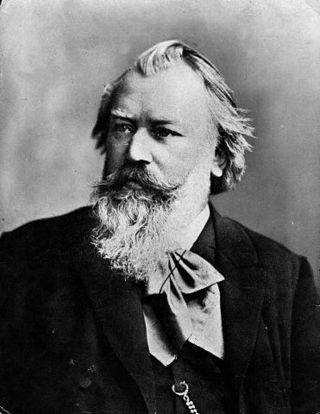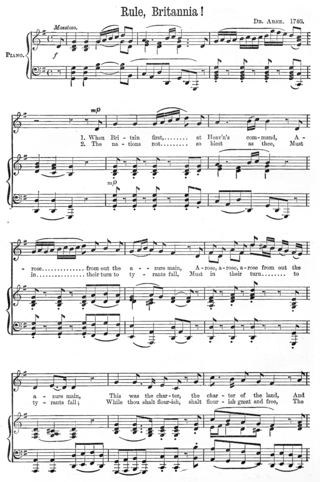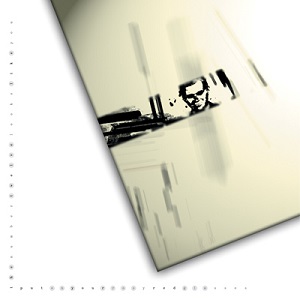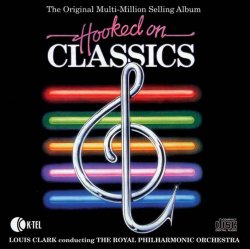
Johannes Brahms was a German composer, pianist, and conductor of the mid-Romantic period. Born in Hamburg into a Lutheran family, he spent much of his professional life in Vienna. He is sometimes grouped with Johann Sebastian Bach and Ludwig van Beethoven as one of the "Three Bs" of music, a comment originally made by the nineteenth-century conductor Hans von Bülow.
Sonata form is a musical structure generally consisting of three main sections: an exposition, a development, and a recapitulation. It has been used widely since the middle of the 18th century.
A symphonic poem or tone poem is a piece of orchestral music, usually in a single continuous movement, which illustrates or evokes the content of a poem, short story, novel, painting, landscape, or other (non-musical) source. The German term Tondichtung appears to have been first used by the composer Carl Loewe in 1828. The Hungarian composer Franz Liszt first applied the term Symphonische Dichtung to his 13 works in this vein, which commenced in 1848.
"If You're Happy and You Know It" is a popular traditional repetitive children's song, folksong, and drinking song. The song has been noted for its similarities to "Molodejnaya", a song appearing in the 1938 Soviet musical film Volga-Volga.
This article is about music-related events in 1880.

"Rule, Britannia!" is a British patriotic song, originating from the 1740 poem "Rule, Britannia" by James Thomson and set to music by Thomas Arne in the same year. It is most strongly associated with the Royal Navy, but is also used by the British Army.

Freiherr Hans Guido von Bülow was a German conductor, virtuoso pianist, and composer of the Romantic era. As one of the most distinguished conductors of the 19th century, his activity was critical for establishing the successes of several major composers of the time, especially Richard Wagner and Johannes Brahms. Alongside Carl Tausig, Bülow was perhaps the most prominent of the early students of the Hungarian composer, virtuoso pianist and conductor Franz Liszt; he gave the first public performance of Liszt's Sonata in B minor in 1857. He became acquainted with, fell in love with and eventually married Liszt's daughter Cosima, who later left him for Wagner. Noted for his interpretation of the works of Ludwig van Beethoven, he was one of the earliest European musicians to tour the United States.
Sonata form is one of the most influential ideas in the history of Western classical music. Since the establishment of the practice by composers like C.P.E. Bach, Haydn, Mozart, Beethoven, and Schubert and the codification of this practice into teaching and theory, the practice of writing works in sonata form has changed considerably.
This is the discography of Simon Rattle and other produced works by the English conductor.

Put on Your Rosy Red Glasses is the debut studio album by American mathcore group the Number Twelve Looks Like You. It has been reissued twice since its original release by Brutal Records, and once by Silent Pendulum Records as a 20th anniversary celebration. It has been regarded as the band’s heaviest release.

Comedy music or musical comedy is a genre of music that is comic or humorous in nature. Its history can be traced back to the first century in ancient Greece and Rome, moving forward in time to the Medieval Period, Classical and Romantic eras, and the 20th century. Various forms of comedic musical theatre, including "musical play", "musical comedy", "operetta" and "light opera", evolved from the comic operas first developed in late 17th-century Italy. Popular music artists in the 20th century interested in comedy include Allan Sherman, Frank Zappa, Tiny Tim, Barenaked Ladies, Randy Newman, and "Weird Al" Yankovic. Artists in the 21st century include Tenacious D, Flight of the Conchords, The Lonely Island, Ninja Sex Party and The Axis of Awesome.
Although Franz Liszt provided opus numbers for some of his earlier works, they are rarely used today. Instead, his works are usually identified using one of two different cataloging schemes:

Pyotr Ilyich Tchaikovsky struggled with sonata form, the primary Western principle for building large-scale musical structures since the middle of the 18th century. Traditional Russian treatment of melody, harmony and structure actually worked against sonata form's modus operandi of movement, growth and development. Russian music—the Russian creative mentality as a whole, in fact—functioned on the principle of stasis. Russian novels, plays and operas were written as collections of self-contained tableaux, with the plots proceeding from one set-piece to the next. Russian folk music operated along the same lines, with songs comprised as a series of self-contained melodic units repeated continually. Compared to this mindset, the precepts of sonata form probably seemed as alien as if they had arrived from the moon.
Musical quotation is the practice of directly quoting another work in a new composition. The quotation may be from the same composer's work (self-referential), or from a different composer's work (appropriation).

Hooked on Classics, produced by Jeff Jarratt and Don Reedman, is a multi-million selling album recorded by Louis Clark and the Royal Philharmonic Orchestra, published in 1981 by K-tel and distributed by RCA Records, part of the Hooked on Classics series.

Temperance songs are those musical compositions that were sung and performed to promote the Temperance Movement from the 1840s to the 1920s. It was a distinct genre of American music. In 1830 the US per capita consumption of alcohol was 9.5 gallons yearly, almost four times the rate of consumption in 2008. In response, many temperance organizations formed over the next eighty years. Some temperance song lyrics were sung with already well-known songs of the period, for example, "Oh! Susanna". This Stephen Foster melody was used with lyrics in support of temperance and the title changed to “There's A Good Time Coming,” in 1857, ten years after the publication of the original lyrics of "Oh! Susanna".
The Fantasia on Auld Lang Syne is a piece for orchestra composed by the British light music composer Ernest Tomlinson in 1976. The original version was written for 16 saxophones. It was orchestrated in 1977 and there were later arrangements made for concert band and for "two pianos and two turnovers".








